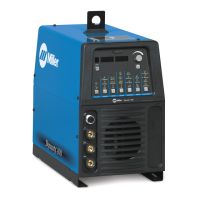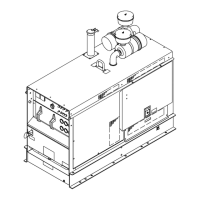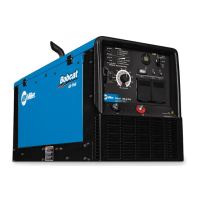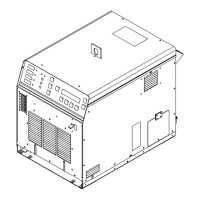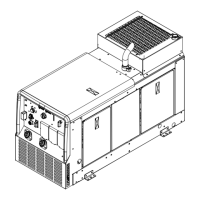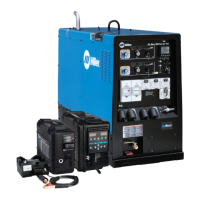OM-253 906 Page 48
6-1 . Operational Terms (Continued)
Pulse
(Pro-Pulset)
An advanced pulse spray transfer process suited for the fill and cap passes on pipe. The Pulse process utilizes
constant current ramps with constant voltage control of peaks and backgrounds. Adaptive response is
controlled by peak and minimum current levels. Benefits are shorter arc lengths, better puddle control, more
tolerance of tip-to-work variation, less audible noise, no arc wandering, allows weld to fill in at toes increasing
travel speed and deposition, and more tolerant to poor fit up and gaps. Settings for Pulse include Arc Length,
Wire Speed and Arc Control.
Purge Method for energizing the gas valve(s) to purge gas lines before welding and to preset gas pressure at the
regulator (see Section 6-9, 11).
RMD RMD stands for Regulated Metal Deposition, a precisely controlled short-circuit transfer process. Benefits of
RMD are well suited to root pass welding on pipe, improves gap filling and spatter reduction. Provides less heat
input into the workpiece, minimizes distortion and allows use of larger diameter wire on thin gauge materials.
Settings for RMD include Arc Length, Wire Speed and Arc Control.
Stick (SMAW) Stick (SMAW) welding uses a flux covered consumable electrode that produces a shielding gas and slag to
shield the arc and molten weld puddle.
Synergic Synergic refers to the unit’s ability to use preprogrammed parameters to determine the actual pulse settings of
Peak Amperage, Background Amperage, Pulse Frequency, and Pulse Width at any specific wire feed speed
setting. This is a characteristic used in RMD and Pulse processes.
TIG (GTAW) TIG (GTAW) welding uses a non-consumable tungsten electrode and shielding gas to produce a strong, clean,
high quality weld.
Trigger Hold This feature reduces welder fatigue by allowing continuous welding without holding the trigger. See Section 6-9
item 10 to set up the Trigger Hold feature.
Trigger Select This feature allows the operator to select MIG processes in Memory Locations 1-4 by pressing the gun trigger.
See Section 6-2 item F 6 to set up the Trigger Select feature.
Trim See Arc Length description.
Volts Preset voltage in MIG mode at idle, actual voltage while welding, and 10 seconds hold value at end of weld.
Wire Diameter Selection of wire diameter for MIG RMD and Pulse processes. The 0.9, 1.0 or 1.2 wire size must be selected for
MIG RMD and Pulse processes. The 0.9 to 1.6 wire sizes can be used with FCAW, but a wire selection is not
required.
Wire Type Selection of wire type (carbon, metal core or stainless).
WFS Term used to represent wire feed speed. In MIG mode, wire feed setting is independent of voltage setting. In
Pulse and RMD, adjusting wire feed speed also increases power level on wire electrode (one knob control).
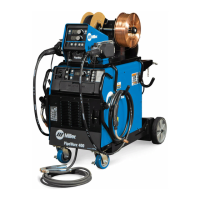
